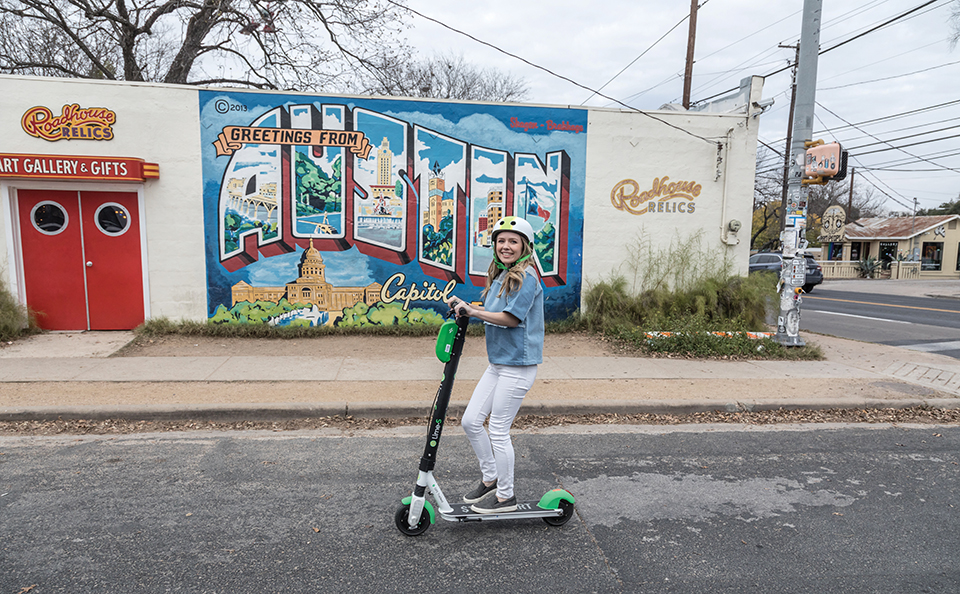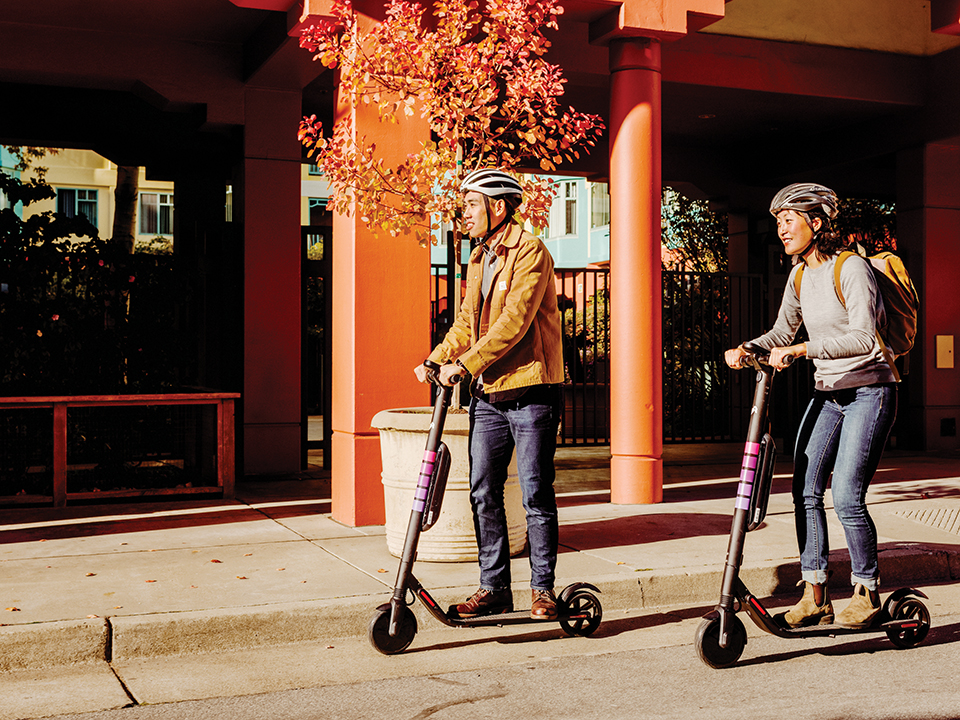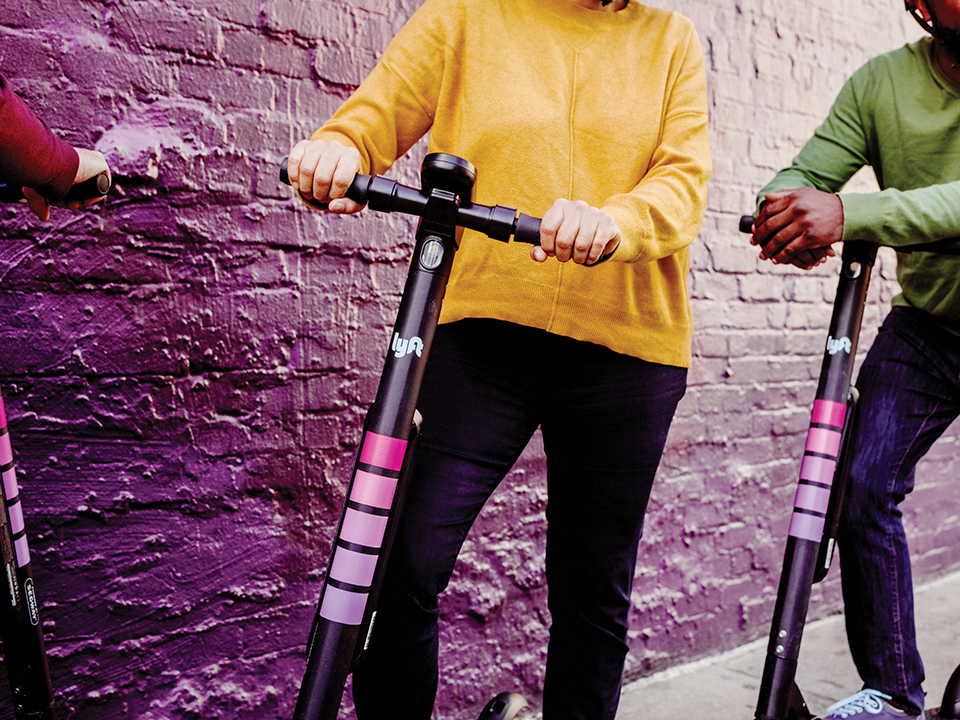The Good, the Bad and Micro-Mobility

It started with just a small flock of “Bird” sporadically stationed throughout the sidewalks of Austin. It would catch your eye as it zoomed on by while you were stuck in traffic or waiting for the bus.
Next came the bunches of Limes sprouting across the streets. The bright green lights blurred past you at crosswalks. Before you knew it, there were more and more — orange ones, red ones, striped ones, clunkier ones and slimmer ones. If you were to see a spotted one now, it likely wouldn’t phase you.
The electric scooters have quickly become a part of the sidewalk culture here in Austin, Texas, since being dropped in April 2018. They congregate at the corners of popular destinations, leaning against Home Slice on South Congress and stacking in mountains at 7th Street and Trinity.

photography by Kris Krug // model Audrey Smith // for Lime
Near the University of Texas campus, there are rows of them along The Drag and outside popular student apartment complexes. With 10 companies licensed by the city to operate in the Austin area, that’s over 17,000 electric vehicles lined up wherever consumers need them. And aptly so for riders like Eric Gosin, a senior government major at UT.
“I’ll ride them to class when I’m late,” Gosin says. “They make getting around campus a lot easier since it’s never hard to find one.”
Part of the reason the scooters are so available is the fact that they are dockless. “Dockless transportation,” defined by the city, means that there is no specific destination to return the vehicle to or any place to pick them up. To use one, you download the corresponding app, which has a map showing the nearest charged scooters. You just scan with your smartphone, activate and ride away.
Gosin points out that this is convenient, but that it also causes problems when people start throwing scooters into bushes and streets. Since there is no dock, when the ride is over, the scooters often get tossed aside — usually to the sidewalk or hard-to-reach alleyways, but sometimes the brave souls that go out into the dead of night to round up the scooters for charging have to fish them out of ponds or, even worse, piles of horse dung on 6th Street.
Koji Pedersen, a senior mechanical engineering major at UT, has been charging scooters each week since February, making about $4 per scooter. Pedersen explains that each company has its own way of going about the charging process — some have you charge at your own expense. Others, like JUMP by Uber, have their own facility that requires you to charge the scooters.
“I started charging because I’m a full-time student, and I don’t have time for a day job,” Pedersen says. “There’s no quota or hours to meet. It’s a nice extra 40 bucks a week.”

Once the sun goes down, you’ll see vans, pickup trucks and trailers loading up on the dead scooters. Working quickly and methodically, the pro chargers that make the most money have it down to an art. Hitting the most saturated spots first before the other chargers get there.
“It is every man for himself,” Pedersen explains. “You are trying to beat the other chargers to scooters because every scooter collected is $4 to $5 to your pocket.”
Interestingly enough, Pedersen himself prefers to bike to class, and if he does end up using a scooter, he uses JUMP because of the no start-up fee.
Many reasons for riders to opt for other means of transportation aren’t just about start-up fees or pre-owned bikes. Much of the initial introduction of the scooters were met with injuries and traffic accidents. Stories of dislocated arms, broken noses and twisted ankles became common themes when electric scooters came up in cafe conversations.
Perhaps the death of UT student, Mark Sands, in February, while riding one of the scooters serves as the biggest indication that there are still several issues that need to be addressed when it comes to this micro-mobility takeover.
Issues like enforcing helmet-wear, legal and illegal riding zones and speed, as well as ensuring available scooters are up to code and functioning properly.
Even Gosin spoke to these issues, saying that the speed and the operation of the scooters leave him feeling uncomfortable riding them too frequently. He says they go a bit faster than most people expect them to, which can make the adjustment difficult at first.
“They can be dangerous around campus with so many other people on them and cars everywhere,” Gosin says. “They’re not very easy to turn quickly, and they can’t stop as quickly as they speed up. I’ve had to veer off of the road a few times just to avoid hitting things in front of me.”
Mary Vo, a public information specialist with the City of Austin Transportation Department, explains that the city is attempting to improve the safety regulations through education and awareness as quickly as the technology is showing up.
“As our mobility landscape changes with newer innovation for getting around Austin, our city must be responsive and adaptable to ensure that the incorporation of these services is safe,” Vo says.
Even the scooter companies themselves have taken part in working with cities like Austin to create better options for the riders. Some have made pushes for greener transportation throughout the country, and Lime points to the need for more scooter-related infrastructure within Austin.

Sam Sadle, with Lime Government Relations and Strategic Development, explains that consumers themselves want the infrastructure, stating that they found 52.2 percent of its riders preferred a protected bike lane as their choice for riding.
“Austin has embraced Lime scooters,” Sadle says. “And we continue to work with the City of Austin to support infrastructure for shared scooters.”
As the city grapples with this new form of transportation — and the pros and cons that come with it — Austinites can stay up to date on the regulations through the Transportation Department and its rules and handbooks on usage.
As Austin is a hub for technological innovation, it makes sense to use it as an experiment city for electric scooters. Austinites have been eager to take advantage of the pros scooters offer — like reductions in traffic congestion, emissions and convenience factors for riders. Any setbacks the companies have faced have provided feedback that helps scooter companies navigate new technology wants and needs.
Odi Agenmonmen, the Texas market manager for Lyft, says that scooters are a powerful and environmentally friendly short-route means of transportation in Austin. Paired with existing mobility options, the improvements that can be made will change the way cities function.
“Lyft views the successful integration of scooters in Austin as part of a bigger movement,” Adenmonmen says. “To design cities for people — not just cars.”






